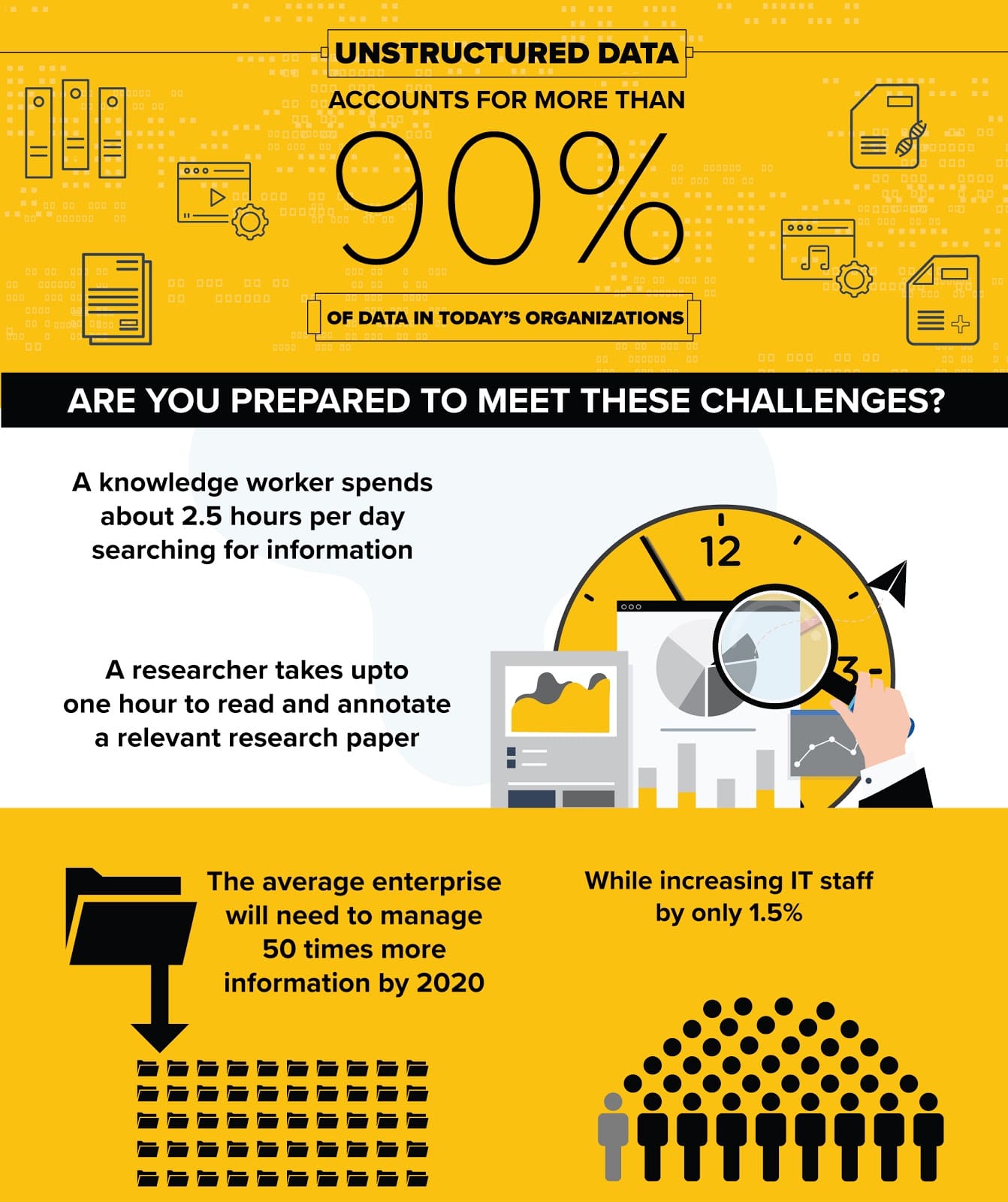
AI pioneer Innoplexus and phytopharmaceutical company DrD are partnering toRead More

AI pioneer Innoplexus and phytopharmaceutical company DrD are partnering toRead More
Jun 24
Apr 24

Innoplexus wins Horizon Interactive Gold Award for Curia App
Read MoreDid you write a mail today? Or did you use facebook, twitter, or Instagram? Regardless, chances are high that you produced some so-called unstructured data. But, what exactly is unstructured data?
Unstructured data is digitized information that is available in a non-formalized structure. It is not relational and is not organized in a uniform, pre-defined traditional row-column database. Unstructured data is not readable by machines. Often it is represented by digital natural language text, audio, or video. Take an eMail: The file type of an eMail is consistent, the content in contrast not. Another example is an HTML web page: HTML typically serves solely for the purpose of rendering. It does not capture the meaning of the tagged elements for automated processing of the content on the page, eg. the semantic meaning of tagged terms. In comparison to unstructured data, structured data has a rigid format to ensure consistency in processing and analyzing it, written in a relational database with unique names for the respective columns. One can tell which content is to be found in which field.

The synonyms of “unstructured” are shapeless, unorganized, irregular, not having a system or hierarchy. However, this is not the case with unstructured data. A lot of this unstructured data is in some way structured by having a specific system: A copywriter will structure the text into an introduction, hypothesis, supporting evidence, conclusion, subheadings, columns, and paragraphs for a better understanding. This text definitely has a structure. The same relates to audio and video files – otherwise, no tools or even humans would be able to recognize and process them.
Sometimes we also use the term disparate data – dissimilar, unequal, distinctly different – for this kind of data. Meaning that every single information can have a variable structure. Before a computer can make sense of the data it needs to identify the structure from all these different data types and formats. Unstructured data can be:

More than 2.5 quintillion bytes of data are created by consumers, businesses, and machines every day, across the globe. Experts estimate that 80-90% of all digital information accounts to unstructured content. For instance, that’s more than 570 new Websites that are created every minute of the day. 70% of the digital universe is generated by users. And the amount of unstructured data is growing significantly, many times faster than how the structured databases are growing.
Storage is the first challenge one faces with unstructured data: However, big data platforms like Hadoop clusters or NoSQL databases provide scalable, distributed infrastructure for fast processing, storing, and managing large volumes of unstructured data without the obligation of a common data model and a single database schema, as in relational databases or data warehouses. Unlike the predefined, predictable format used by relational databases, NoSQL data stores can handle data in any format.
As with structured data, simply collecting unstructured data will not get you relevant insights. Unstructured data must also be properly organized. Issues like data quality and context are important. To make big data work, it needs to wrangle varied types that aren’t linkable. Traditional approaches will not deliver relevant insights, find undiscovered patterns, or otherwise, interpret this information. Artificial intelligence (AI) and natural language processing (NLP) have made it possible to automatically categorize and analyze unstructured data and utilize the linguistic, auditory, and visual structure that exists in all forms of human communication.
Text analytics tools look for patterns, keywords, and sentiment in textual data by examining word morphology, sentence syntax, as well as other small-scale and large-scale patterns. AI transcripts are audio to text files. In fact, some image recognition algorithms have achieved human-level results in extracting information from video and images.
In order to generate value from unstructured data, meta-data from content such as concepts, entities, keywords, categories, sentiment, emotion, relations, semantic roles, etc. need to be extracted using natural language understanding. Deep learning algorithms that use neural networks aid to analyze data seeking to understand complex problems, such as interpreting images or text-based natural language and human speech.
Data as a Service / API services that let users hand-off data to a fully trained cognitive system help in gaining value from unstructured data. This means that enterprises don’t have to keep deep learning experts on staff. However, a deep understanding of business and domain knowledge is required to make sure that the algorithms return true positive correlations. For example, biomedical research generates a major source of unstructured data as researchers often publish their findings in scientific journals. Complicated technical vocabulary and the domain knowledge required to fully contextualize observations make it challenging to derive structural elements. Analyses can leverage clues regarding new disease therapies.

Data volumes will continue to grow exponentially as new data sources and systems derive. The future belongs to unstructured data and the valuable business insights it contains for a deeper understanding of what makes businesses move forward. Companies need to evolve their business intelligence processes by properly collecting and synthesizing unstructured and structured data in order to get comprehensive and more actionable insights.
In most cases, unstructured data is ultimately related back to a company’s structured data records. For example, every x-ray image is related back to the patient’s record in the hospital’s record system. The patient record is enriched with unstructured data that is linked to it, and the doctor gets a complete picture of the patient’s problems and needs. Similarly, content from social streams such as blogs, tweets, comments, and ratings reflect the current state of public sentiment at any given point in time. This unstructured data can be a direct line into the hearts and minds of customers.
Big Data analytics is a technology-driven strategy. It provides insights with greater levels of detail, depth, and precision-into the behavior of customers, companies, and the competitive advantage. Unstructured data enriches corporate data and enables leaders to work smarter. If organizations can process the constantly flowing data stream in real time, they can make time-critical decisions faster, observe new trends, promptly make course corrections, respond more quickly to changing customer sentiment, and take advantage of new business opportunities.
The cost of developing a new drug roughly doubles every nine years (inflation-adjusted) aka Eroom’s law. As the volume of data…
There was a time when science depended on manual efforts by scientists and researchers. Then, came an avalanche of data…
Collaboration with key opinion leaders and influencers becomes crucial at various stages of the drug development chain. When a pharmaceutical…
Data are not the new gold – but the ability to put them together in a relevant and analyzable way…
Artificial intelligence, or AI, is gaining more attention in the pharma space these days. At one time evoking images from…
Artificial intelligence (AI) is transforming the pharmaceutical industry with extraordinary innovations that are automating processes at every stage of drug…
There is a lot of buzz these days about how artificial intelligence (AI) is going to disrupt the pharmaceutical industry….
Drug discovery plays a key role in the pharma and biotech industries. Discovering unmet needs, pinpointing the target, identifying the…
The pharmaceutical industry spends billions on R&D each year. Clinical trials require tremendous amounts of effort, from identifying sites and…
Training algorithms to identify and extract Life Sciences-specific data The English dictionary is full of words and definitions that can be…
The early 1970s introduced the world to the idea of computer vision, a promising technology automating tasks that would otherwise…
Summary: AI could potentially speed drug discovery and save time in rejecting treatments that are unlikely to yield worthwhile resultsAI has…